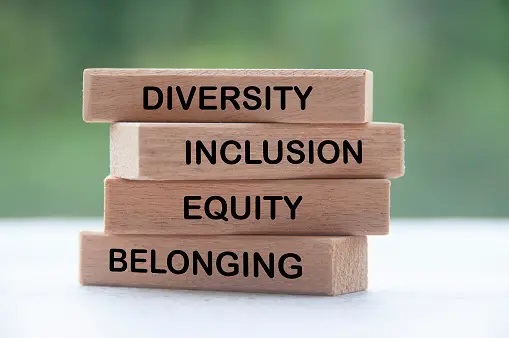By Dawn Metcalf, Ed.M
Recruitment and retention are top priorities for companies competing for high-quality candidates in the competitive job market. Human Resources now focus on what a company can offer a prospective employee in terms of their personal and professional growth, quality of work and home life, and offering a more holistic experience through corporate culture programs and support services. This “personal to personnel” approach has become its own entity, designed to recognize the individual and value their contributions. It has become a recent addition to the DE&I umbrella, adding the letter B for “Belonging” to Diversity, Equity, Inclusion, now DEI&B.
What Does Diversity, Equity, and Inclusion Look Like at Work?
Diversity, Equity, and Inclusion (DEI) is “a conceptual framework that promotes the fair treatment and full participation of all people, especially in the workplace, including populations who have historically been underrepresented or subject to discrimination because of their background, identity, disability, etc.” according to Dictionary.com, which is a convenient shorthand for indicating an organization’s commitment to a supportive, welcoming and evolving corporate culture.
Breaking it down further:
- Diversity is the presence of differentiation within a community, including racial, ethnic, gender, gender identity, sexual orientation, age, socioeconomic, religious, etc.
- Equity is the commitment that all practices, processes and programs offered will be fair and provide equal access and opportunities to all.
- Inclusion is the active practice of creating a feeling of acceptance and being valued.
Belonging is a Key Element for Success
The addition of Belonging seems obvious, but there is a key difference between “belonging” and “fitting in.” For many years, inclusivity was merely the idea that if a company hired staff with a racial minority or disability status, they would have fulfilled their obligation–the optics would be enough. New employees were expected to rise to the occasion–to “fit in”–and be grateful for the opportunity, regardless of whether there were people and places available in order to feel comfortable or appropriate accommodations in order to be able to perform their job successfully. There are always the “unwritten rules” that dictate how you are supposed to dress, talk, act, talk, give and receive feedback, complaints or praise; how big your office is, where your parking space is located, and how you are supposed to feel (or not feel) about any disparity in order to be considered acceptable.
“Fitting in” is the idea that you have to adjust yourself to be like everyone else, while “Belonging” allows you to be yourself, and be valued and respected because of what you bring to the group.
While it may have been easier to recruit candidates, retention rates were staggeringly low, which was the initial excuse for why diversity wasn’t “cost-effective” when, in fact, the truth is the reverse. “If workers feel like they belong, companies reap substantial bottom-line benefits. High belonging was linked to a whopping 56% increase in job performance, a 50% drop in turnover risk, and a 75% reduction in sick days. For a 10,000-person company, this would result in annual savings of more than $52M,” reports the Harvard Business Review. “Employees with higher workplace belonging also showed a 167% increase in their employer promoter score (their willingness to recommend their company to others). They also received double the raises, and 18 times more promotions.”
Belonging welcomes the individual as part of the group, acknowledging our unique differences and respecting their validity. It means not calling out or calling attention to those perspectives or voices to educate, justify or represent any group–and most people identify with multiple intersectionalities–in order to be a contribution. Identity is self-defined and should be accepted and accommodated without judgment. Professional development, opportunities for advancement, and employee supports should be available to all members of an organization, regardless of their social status.
How Can Organizations Make A Difference?
Pathways at Work believes that true belonging extends to support a company’s mental health needs in a way that mindfully supports DEI&B. By offering mental health services to everyone equally, professional experts can promote a sense of belonging, of not being the only one who may be struggling or seeking support. It underscores that the company values not only the overall health of the organization and its culture, but also each individual, meeting them wherever they happen to be on their personal journey.
Participation as a group identity:
- Allows each person the freedom to self-identify without being singled-out
- Educates without excluding, spotlighting, or reinforcing “otherness”
- Speaks to the group as a whole, acknowledging that everyone can benefit
- Supports individuals to think of themselves and each other as part of a team
- Provides an anonymous intervention that encourages individuals to seek out further help and resources, if necessary
- Explores issues around mental health without stigma
By allowing everyone to experience the mental health conversation together, we can promote a healthier, happier corporate culture where everyone truly belongs.
*This article first appeared on the Pathways website
*Dawn Metcalf (Ed.M., Harvard) is a published author, educator and prevention specialist with a focus on sex, gender, orientation and self-esteem.

